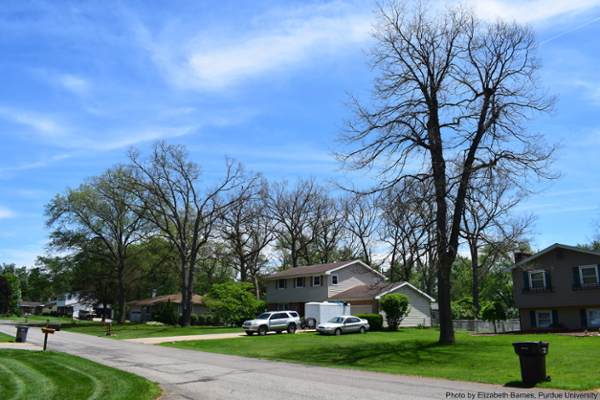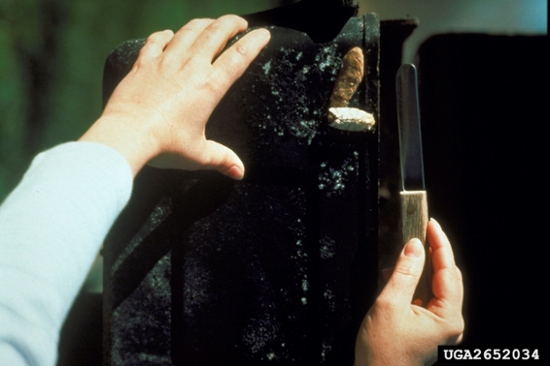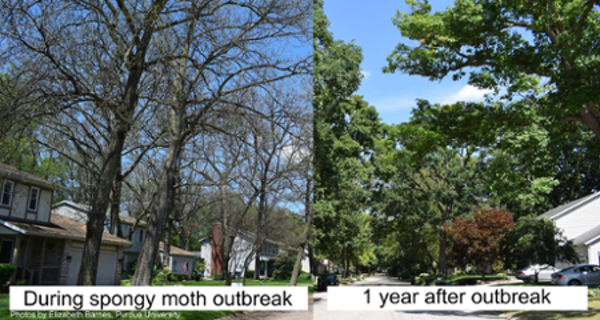Management
Impact of Spongy Moth Damage
The impact of spongy moth caterpillars varies greatly from year to year. During years when few spongy moth caterpillars are present, they may go unnoticed. They only harm tree health when numerous during outbreak years. Outbreaks are more likely to occur following a dry spring. The seriousness of the damage depends on the species of tree, its overall health, and the number of other stresses it experiences before and after the defoliation. Arborists and other green industry professionals trained in assessing tree health, should be able to determine the health of a specific tree.
If spongy moth defoliates my trees, will they die?
- LIKELY TO RECOVER
- A healthy deciduous tree that loses more than half of its leaves during the summer AND it doesn’t experience any additional stress for at least a year.
- LESS LIKELY TO RECOVER
- A healthy deciduous tree that loses more than half of its leaves two years in a row.
- LEAST LIKELY TO RECOVER
- A deciduous tree that loses more than half of its leaves AND is already stressed or is stressed the following year (e.g. from drought, disease, disturbance)
- WILL NOT RECOVER
- An evergreen tree that loses more than half of its leaves during the summer
Management for Homeowners
Destroy egg masses BEFORE eggs hatch in April: Spongy moths hide their egg masses in dark, protected areas like windowsills, tires, tree trunks, and under outdoor furniture.
Saturate egg masses with an approved oil. One oil that is labeled for this use includes Golden-Pest Spray Oil (soybean based). Follow label direction for mixing and saturate all the egg masses you can reach with a sprayer.
Remove egg masses. Slide the blade of a knife or paint scraper under the egg mass, lift the mass off, and dispose of it. Be careful not to cut the tree when scraping. Destroy egg masses by soaking them in a bucket of soapy water for 48 hours. If you leave eggs on the ground or just step on them, a significant number may survive to hatch in the spring.
Hiding band traps: Large spongy moth caterpillars migrate down the trunk of the tree during the heat of the day to find shade and to hide from predators. They move back up the tree in the evening to feed. Burlap bands can be wrapped around tree trunks to collect caterpillars that hide during the day. Caterpillars can be collected in the afternoon and killed by soaking in a bucket of soapy water to reduce the spongy moth population.
- Cut a strip of burlap or medium weight dark cloth about 12 to 18 inches wide and long enough to completely encircle the tree at chest height.
- Wrap the burlap around the tree.
- Tie string or twine or wrap wire around the burlap 6 inches from the top edge. Then fold the top part of the cloth down over the bottom half, creating a tent-like area for caterpillars to hide in.
- Check the bands every afternoon. Wear gloves to collect the trapped caterpillars and drop them into a bucket of soapy water and let them soak for 48 hours to kill them.
- How to make soapy water: Add 3 fluid ounces of dish soap, or the amount of laundry detergent recommended to clean heavily soiled clothes.
Insecticides:
Canopy Sprays: Although insecticides can be applied to control spongy moth during outbreaks, it is often impractical for two reasons. First, professional equipment is needed to reach the leaves when trees are greater than 12 ft tall. Second, professionals with high pressure sprayers may not be able to get effective coverage due to excessive tree height or neighborhood concerns about insecticide drift. In addition, these insecticides are more effective on small caterpillars and may need to be applied twice during a season.
Despite these concerns a number of effective products are available. Sprays of biological insecticides like Bacillus thuringiensis when caterpillars are less than 1-inch long can provide protection without harming beneficial insects. Other products that kill caterpillars and are relatively safe to beneficials include azadirachtin, chlorantraniliprole, indoxacarb, spinosad, and tebufenozide. Commonly available, broad -spectrum insecticides that may inadvertently kill beneficial insects and caterpillars include, acephate, bifenthrin, carbaryl, cyantraniliprole, cyclaniliprole, cyfluthrin, fluvalinate, lambda-cyhalothrin, malathion, or permethrin when applied in accordance with label directions.
Soil Applications of Insecticide may provide a viable alternative to canopy treatments because they avoid the drift associated with canopy sprays. Currently acephate has several formulations labeled for this use. When applying product to the soil, it is critical to follow label instructions to apply enough product to achieve protection on larger trees but also avoid contaminating waterways and killing non-target organisms. During cool springs when gypsy moth development is slow, a second drench may be needed.
Trunk injections of insecticide can be an effective, albeit expensive, alternative to soil and foliar applications. These products should be injected by a professional for best results and minimal tree injury. Emamectin benzoate must be applied annually to control defoliators like spongy moth despite its ability to protect ash trees from emerald ash borer for 3 years. A single injection will last an entire season. Acephate is available in an injectable formulation that kills caterpillars although the residual effect or how long it lasts in the tree is not as long as emamectin benzoate.
Double check the ALL INSECTICIDE LABELS to make sure it’s approved for use on spongy moth (note: some products may still list this insect as gypsy moth) and follow the label directions carefully.
Community Management
To reduce control costs when living in an area where there are enough spongy moths to defoliate trees, members of your community could consider banding together to manage spongy moth utilizing professional ground or aerial treatments. When there are more than 250 spongy moth egg masses per acre during the winter, the area is likely to be defoliated the following spring.
Aerial Application: Aerial applications are less expensive and more effective than applications from the ground. Contact the Indiana Department of Natural Resources Division of Entomology (317-232-4120) or Division of Forestry (317-232-4105) to get a list of aerial applicators for hire.
National Level Management
The Slow the Spread program is a national effort to prevent or delay the spread of spongy moth. This management program has been shown to be a cost-effective way of dealing with this invasive insect. The program assigns counties one of three management types based on the history of spongy moth in that area: eradication, slow the spread, or suppression. Eradication zones are areas without a history of an established population of spongy moth. The program will attempt to kill all populations of spongy moth in these areas. Slow the spread areas are located in the boundary between infested and uninfested areas. The goal in this area is to prevent the spread of spongy moth from the infested areas to the uninfested areas. Finally, the suppression zones are the areas that are already infested with spongy moth. In these areas, efforts go towards knocking down outbreaks, high density areas, and protecting key trees.
Spongy moth management often employs BTK or pheromones to slow the growth of spongy moth infestations and to slow the spread areas. These treatments are highly targeted at spongy moth to reduce the chance of other organisms being affected.
BTK (Bacillus thuringiensis var. kurstaki)
BTK is a bacteria that is naturally found in the environment that can be used in spongy moth management. There are different strains of Bacillus thuringiensis that attack different types of insects, but BTK only kills caterpillars like spongy moth. It typically lasts about 3-5 days after application so it is unlikely to build up in the environment through management efforts. BTK may have some non-target effects as it kills all kinds of caterpillars, not just spongy moth, but it
doesn’t harm other insects or vertebrates (e.g. people, cats and dogs, birds, etc.). To learn more, see our BTK Q&A.
Pheromones
Spongy moth females produce a pheromone that attracts male moths. An artificial version of these pheromones is used in management to confuse male moths and prevent them from finding a mate. In small drops the pheromone is applied to the forest canopy just before the moths typically mate at the end of June. This reduces the total number of eggs laid and can dramatically cut down a population of spongy moth. The smell they produce only lures male spongy moths and has no impact on other types of moths, butterflies, or any other organism. To learn more, check out our Q&A.
To find out more about the Slow the Spread program in Indiana, check out the Indiana DNR’s Spongy Moth Page.
Report Sightings of Spongy Moth
Great Lakes EDN app on Apple or Android app stores
Email: DEPP@dnr.in.gov
1-866 NO EXOTIC (1-866-663-9684)




